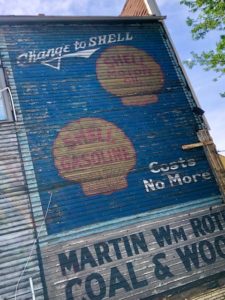 My friend, Steve, sent me an email the other week.
My friend, Steve, sent me an email the other week.
Did you hear about the ghost sign that was discovered near your neighborhood?
I had heard the term before, but I Googled to confirm my understanding. A ghost sign is an old and fading advertising image painted on the exterior wall of a building.
Although I’m not generally a fan of Americana as a look (you won’t find any painted wooden ducks in my home), as a part-time tour guide, you might expect such a sighting would be of interest to me.
In his email, my friend provided a link to an article. After a little more Googling, I learned that this discovery was featured in many news outlets, all eager for “feel good” local news. There were many different angles to the story of this “reveal.”
Displaying ad images on the sides of a building pre-date the Great Depression. They were put up all over the United States and in parts of Europe. Common house paints were often used. The artists behind these works were often referred to as “wall dogs.”
The history of advertising is a compelling subject to many. These days, people might fume over pop-up ads or automatic couponing that take place when a smart phone’s tracking system makes it known that you are shopping in a particular store.
These days, advertising messages are targeted to people who would likely be interested in them and whose credit card details are already stored in the cloud.
For decades, advertising was geared to simply present a product, its value and a happy customer in front of as many people as possible. This usually meant signage. Successful campaigns were likely determined by location traffic and cost to display the image.
Of course, why this painted sign, encouraging motorists to “:Change to Shell – It costs no more” is news has to do with a very current trend.
Old buildings throughout my city (Chicago) and throughout many parts of the country are often forced to make way for something NEW. This ghost sign was discovered because they’re tearing down a building near Addison and Ravenswood so they can put up a new multi-unit residence.
I don’t know that a 1930’s era ad for motor oil can be thought of as paradise, but when I read several different articles online about the tear-down, then went there myself, I couldn’t help but think about Joni Mitchells’ Big Yellow Taxi lyrics.
Don’t it always seem to go.
That you don’t know what you got ’til it’s gone.
They paved paradise and put up a parking lot.
Tearing down buildings and preparing for new construction usually involves several things I’m used to seeing; a rickety metal fence that doesn’t come close to keeping curious onlookers protected and a giant dumpster parked along the street nearby.
I got to thinking about the nature of “discovery.”
My friend shared his discovery of the write-up with me. Subsequently, I discovered several local history buffs also wrote about the sign and the development project. Following my curiosity, I conducted more research and discovered more about advertising from a century ago.
I had to wonder whether the fact of someone else already knowing about something diminishes one’s ability to think of something as “a find.” I love to tell friends about a new, under the radar, restaurant but might be less excited if it’s already been featured on “Check, Please.”
Can something be “discovered” if you’re looking for it and already believe it’s there?
Maybe.
But there is something sort of magical about “discovery” as an unplanned occurrence.
Columbus “discovered” America when he was looking for something else, a quicker trading route to India, China and the Spice Islands. Van Gogh and other famous painters often painted over earlier works and unknown art historians or museum workers followed clues before a treasure was seen by the public.
There’s an expression, “giving up the ghost,” which is used to indicate that someone has stopped “trying.” It generally carries a negative association. Giving up. But maybe, ghost signs surfacing tells a different story; how things can come to light after layers are removed, how important surrendering, not trying, can be in discovery.
Knowing that a discovery is not always about coming across something for the first time, that it can also be about getting to a deeper layer of something that has always been right in front of you, is no small thing.


Leave a comment